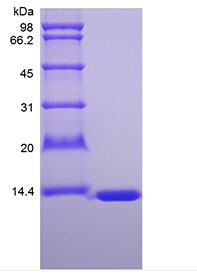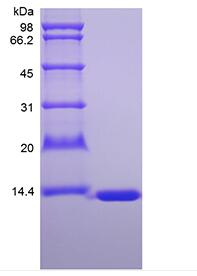

工作时间 :
周一~~周五
9:00 -18:00
在非工作时间,您可以通过邮件订购产品,订购时请写明详细联系方式,谢谢支持!
销售:18321282235
技术:021-60514606
传真:021-37680378


顾经理微信 扫一扫,关注我们

Recombinant Murine Fatty-acid-binding Protein 1
Synonyms 14 kDa Selenium-binding Protein, Fatty Acid-binding Protein 1, L-FABP
Accession P12710
GeneID 14080
Source Escherichia coli.
Molecular Weight Approximately 14.2 kDa, a single non-glycosylated polypeptide chain containing 127 amino acids.
Quantity 5µg/25µg/1mg
AA Sequence MNFSGKYQLQ SQENFEPFMK AIGLPEDLIQ KGKDIKGVSE IVHEGKKIKL TITYGPKVVR NEFTLGEECE LETMTGEKVK AVVKLEGDNK MVTTFKGIKS VTELNGDTIT NTMTLGDIVY KRVSKRI
Purity > 95 % by SDS-PAGE and HPLC analyses.
Biological Activity Fully biologically active when compared to standard. The binding affinity of rMuFABP1 for the synthetic ligand cis-parinaric acid has been measured by fluorescence titration. Half maximal fluorescence of 2.5 μM rMuFABP1 is achieved with approximately 5 μM cis-paranaric acid.
Physical Appearance Sterile Filtered White lyophilized (freeze-dried) powder.
Formulation Lyophilized from a 0.2 µm filtered concentrated solution in PBS, pH 7.4, 2 % trehalose.
Endotoxin Less than 1 EU/µg of rMuFABP1 as determined by LAL method.
Reconstitution We recommend that this vial be briefly centrifuged prior to opening to bring the contents to the bottom. Reconstitute in sterile distilled water or aqueous buffer containing 0.1 % BSA to a concentration of 0.1-1.0 mg/mL. Stock solutions should be apportioned into working aliquots and stored at ≤ -20 °C. Further dilutions should be made in appropriate buffered solutions.
Stability & Storage Use a manual defrost freezer and avoid repeated freeze-thaw cycles.
- 12 months from date of receipt, -20 to -70 °C as supplied.
- 1 month, 2 to 8 °C under sterile conditions after reconstitution.
- 3 months, -20 to -70 °C under sterile conditions after reconstitution.
Usage This material is offered by Shanghai PrimeGene Bio-Tech for research, laboratory or further evaluation purposes. NOT FOR HUMAN USE.
SDS-PAGE

Reference 1. Chmurzynska A. 2006. J Appl Genet. 47:39-48.
2. Weisiger RA. 2002. Mol Cell Biochem. 239:35-43.
3. Chen SH, Van Tuinen P, Ledbetter DH, et al. 1986. Somat Cell Mol Genet. 12:303-6.
4. Weickert MO, Loeffelholz CV, Roden M, et al. 2007. Am J Physiol Endocrinol Metab. 293:E1078-84.
5. Bassuk JA, Tsichlis PN, Sorof S. 1987. Proc Natl Acad Sci U S A. 84:7547-51.
6. He Y, Yang X, Wang H, et al. 2007. Biochemistry. 46:12543-56.
Background The fatty-acid-binding proteins (FABPs) are a family of carrier proteins for fatty acids and other lipophilic substances such as eicosanoids and retinoids. These proteins are thought to facilitate the transfer of fatty acids between extra- and intracellular membranes. Fatty acid-binding protein 1 (FABP1) encoded by the FABP1 gene, also known as liver-type fatty acid-binding protein (L-FABP), is a member of FABP family and it is a small, highly conserved, cytoplasmic proteins. In addition, FABP1 binds free fatty acids and their coenzyme A derivatives, bilirubin, and some other small molecules in the cytoplasm. Furthermore, it may be involved in intracellular lipid transport. Through amino acid sequence comparison, murine FABP1 shares 84 % and 94 % a.a. sequence identity with human and rat FABP1.
部门 |
姓名 | 手机 | |||
| 销售部 | 顾先生 | 1916510334@qq.com | 18321282235 | 1916510334 | |
| 技术部 | 技术支持 | 1781364813@qq.com | 13816899465 | 1781364813 |
全国免费电话:18321282235
销售: 18321282235
86-21-60514606
技术: 13816899465
传真: 021-37680378
- Recombinant Human Epidermal Growth Factor GMP...
- Recombinant Human Galectin-1...
- Recombinant Human Interleukin-36 alpha, 158a.a....
- Recombinant Rat Beta-defensin 1...
- Recombinant Human Cyclin-Dependent Kinase Inhibitor 2A, Isoform 1-TAT...
- Recombinant Human Parathyroid Hormone 7-84, 15N Stable Isotope Labeled...
- Recombinant Human Lymphocyte Activation Gene 1 Protein/CCL4L1...
- Recombinant Murine Macrophage Inflammatory Protein-3 alpha/CCL20...
- Recombinant Rat Beta-defensin 4...
- Recombinant Porcine Interleukin-1 beta...








